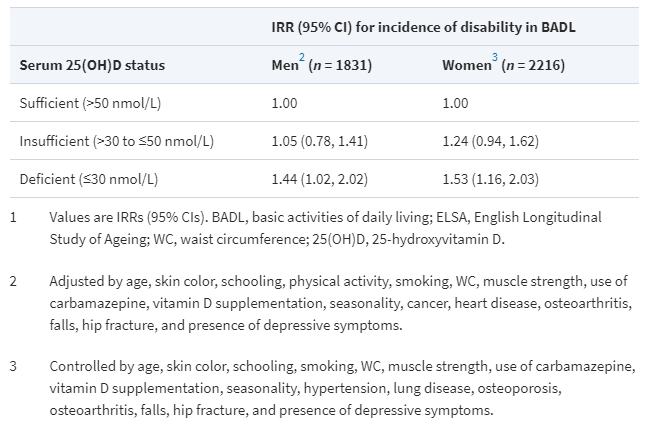Association of Serum 25-Hydroxyvitamin D Deficiency with Risk of Incidence of Disability in Basic Activities of Daily Living in Adults >50 Years of Age
Mariane M Luiz, The Journal of Nutrition, Volume 150, Issue 11, November 2020, Pages 2977–2984,
Background
Vitamin D deficiency compromises muscle function and is related to the etiology of several clinical conditions that can contribute to the development of disability. However, there are few epidemiological studies investigating the association between vitamin D deficiency and the incidence of disability.
Objectives
We aimed to assess whether vitamin D deficiency is associated with the incidence of disability in basic activities of daily living (BADL) and to verify whether there are sex differences in this association.
Methods
A 4-y follow-up study was conducted involving individuals aged 50 y or older who participated in ELSA (English Longitudinal Study of Ageing). The sample consisted of 4814 participants free of disability at baseline according to the modified Katz Index. Vitamin D was assessed by serum 25-hydroxyvitamin D [25(OH)D] concentrations and the participants were classified as sufficient (>50 nmol/L), insufficient (>30 to ≤50 nmol/L), or deficient (≤30 nmol/L). Sociodemographic, behavioral, and clinical characteristics were also investigated. BADL were re-evaluated after 2 and 4 y of follow-up. The report of any difficulty to perform ≥1 BADL was considered as an incident case of disability. Poisson models stratified by sex and controlled for sociodemographic, behavioral, and clinical characteristics were carried out.
Results
After 4-y follow-up, deficient serum 25(OH)D was a risk factor for the incidence of BADL disability in both women (IRR: 1.53; 95% CI: 1.16, 2.03) and men (IRR: 1.44; 95% CI: 1.02, 2.02). However, insufficient serum 25(OH)D was not a risk factor for the incidence of BADL disability in either men or women.
Conclusions
[b]Independently of sex, deficient serum 25(OH)D concentrations were associated with increased risk of incidence of BADL disability in adults >50 y old and should be an additional target of clinical strategies to prevent disability in these populations.[/b]














